The 2019 search engine patents you need to know about
Bill Slawski of Go Fish Digital shared which patents topped his list this year.
Please visit Search Engine Land for the full article.
The steps to financial freedom are here. Visit our site if you want to be financially free and live a wealthy lifestyle
Bill Slawski of Go Fish Digital shared which patents topped his list this year.
Please visit Search Engine Land for the full article.
A decade is a long time. I mean, just think back to the end of 2009.
Barack Obama was about to enter his first full year in the White House, Farmville was the flavor of the month with 83 million monthly users on Facebook, and Avatar had just hit movie theatres worldwide, becoming — at the time — the highest-grossing movie ever.
But even then, ten years ago, people were already starting to make big predictions about online video, and its potential to change the world of marketing.
Not all predictions come true — but, as we reach the end of the decade, it’s fair to say that these ones certainly did.
If any marketing trend can lay claim to being the defining tactic of the last ten years, video is surely up there.
A decade ago, video was an expensive, pie-in-the-sky luxury. Since then, it’s become a staple — an accessible, affordable must-have tool to help attract audiences, explain products, and support customers.
And now, as we once again march forward into a brand new decade, new research conducted by Wyzowl strongly suggests:
Wyzowl’s State of Video Marketing Survey is an annual report, now in its sixth iteration. Every year, we ask a range of questions — many of them the same from year-to-year — to evaluate how the video marketing landscape is changing and growing.
This time round, our survey was taken by a sample of 656 unique respondents, consisting of professional marketers and consumers.
85% of businesses use video as a marketing tool. This is actually a slight decrease from last years figure (87%) but still represents a highly significant number, which has generally grown since 2016 (the first time we asked this particular question in this way.)

What’s more, 92% of marketers who use video say that it’s an important part of their marketing strategy — the highest percentage of any year since 2015.
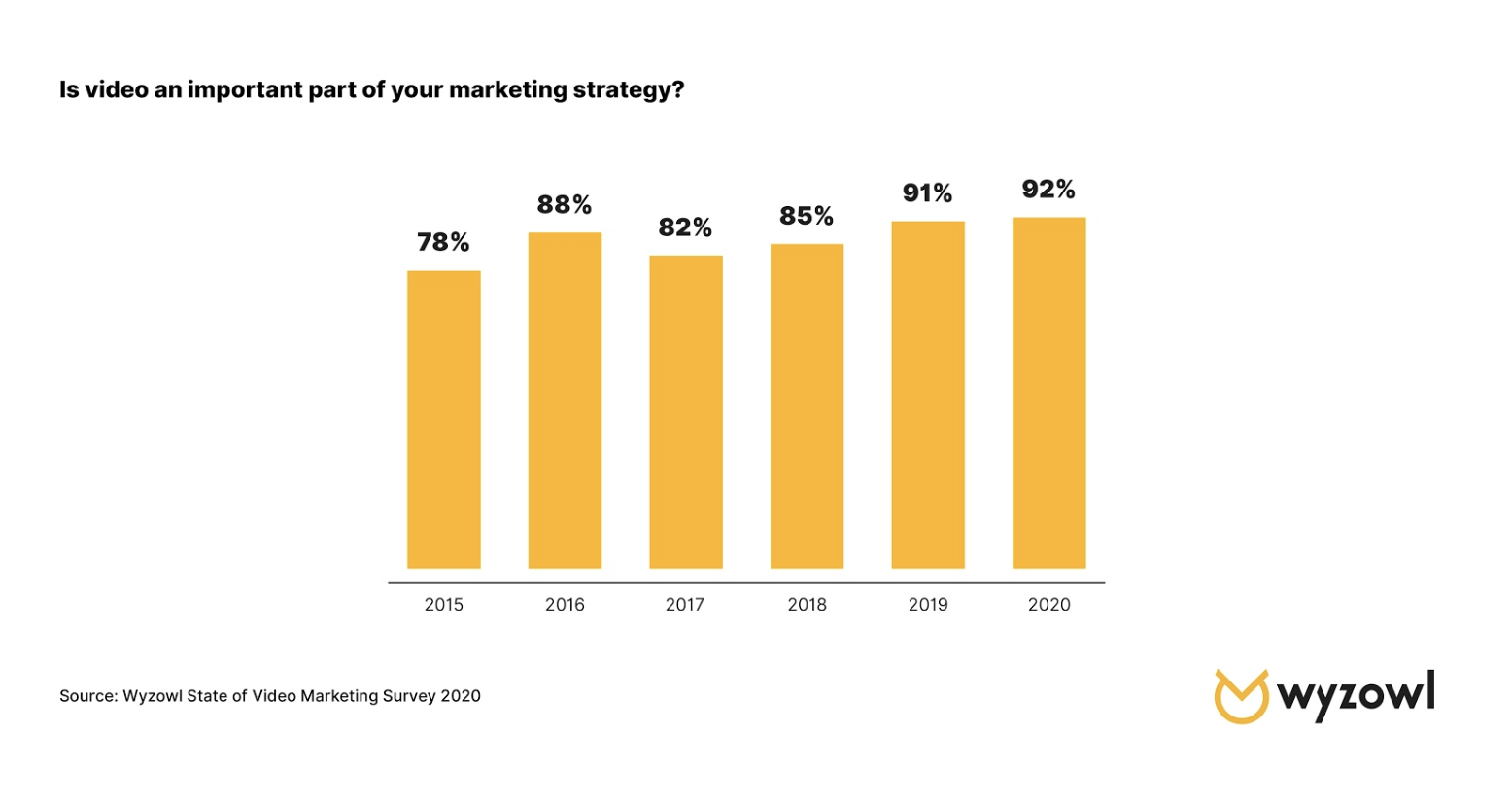
Perhaps most strikingly, 88% of video marketers reported that video gives them a positive ROI — a 5% increase on last years figure, and a world away from the lowly 33% who felt that way in 2015. This could well be attributed to greater understanding of how to use video, as well as how to track and quantify its impact.
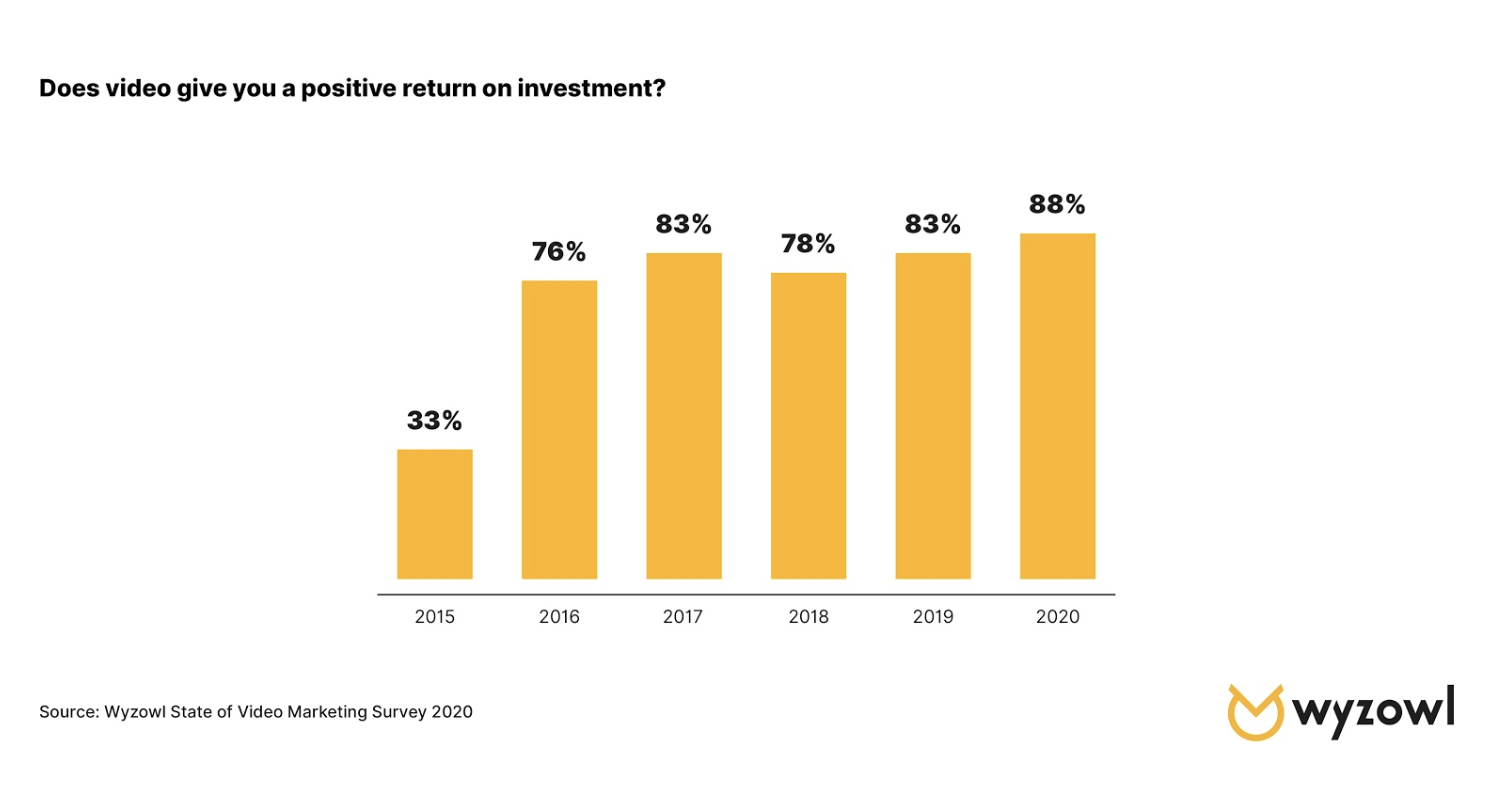
As you might expect given all the above, all the signs suggest that usage and spend are on course to continue their growth in 2020.
99% of current video marketers told us they’ll continue using video in 2020, and 95% plan to increase or maintain their spend.
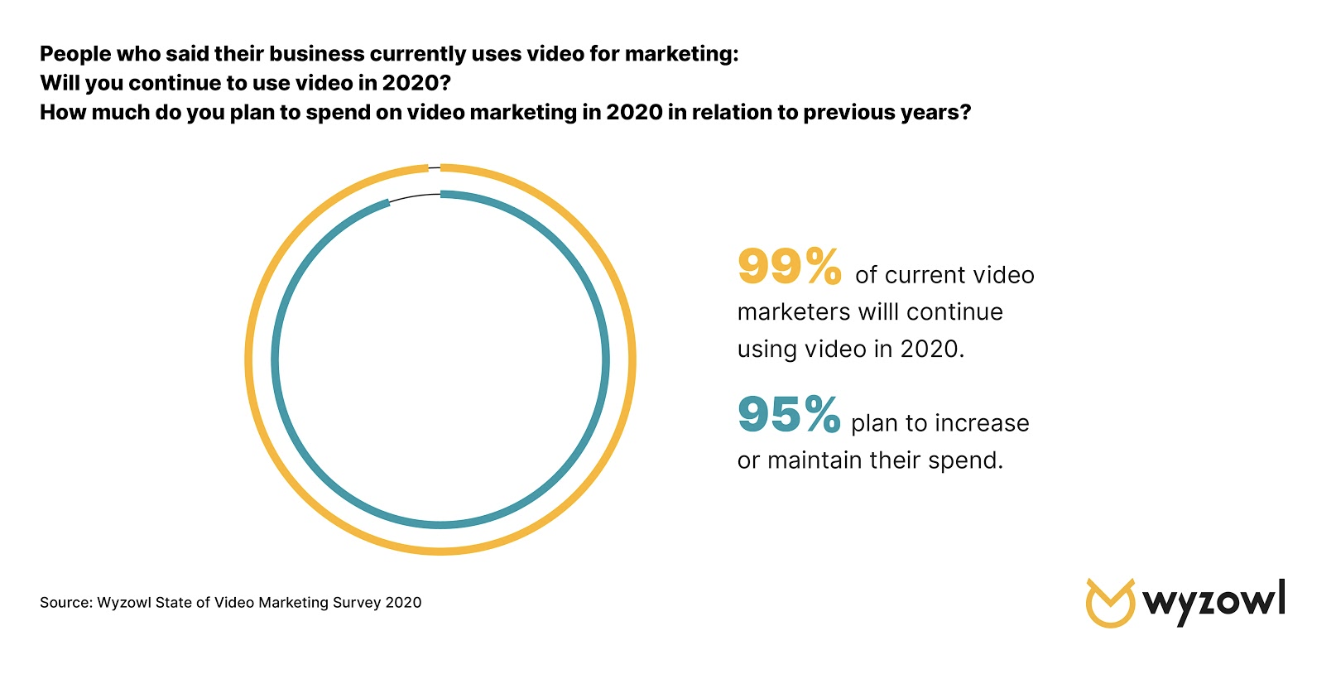
What’s more, from the people who told us they don’t currently use video, 59% told us they expect to start in 2020.
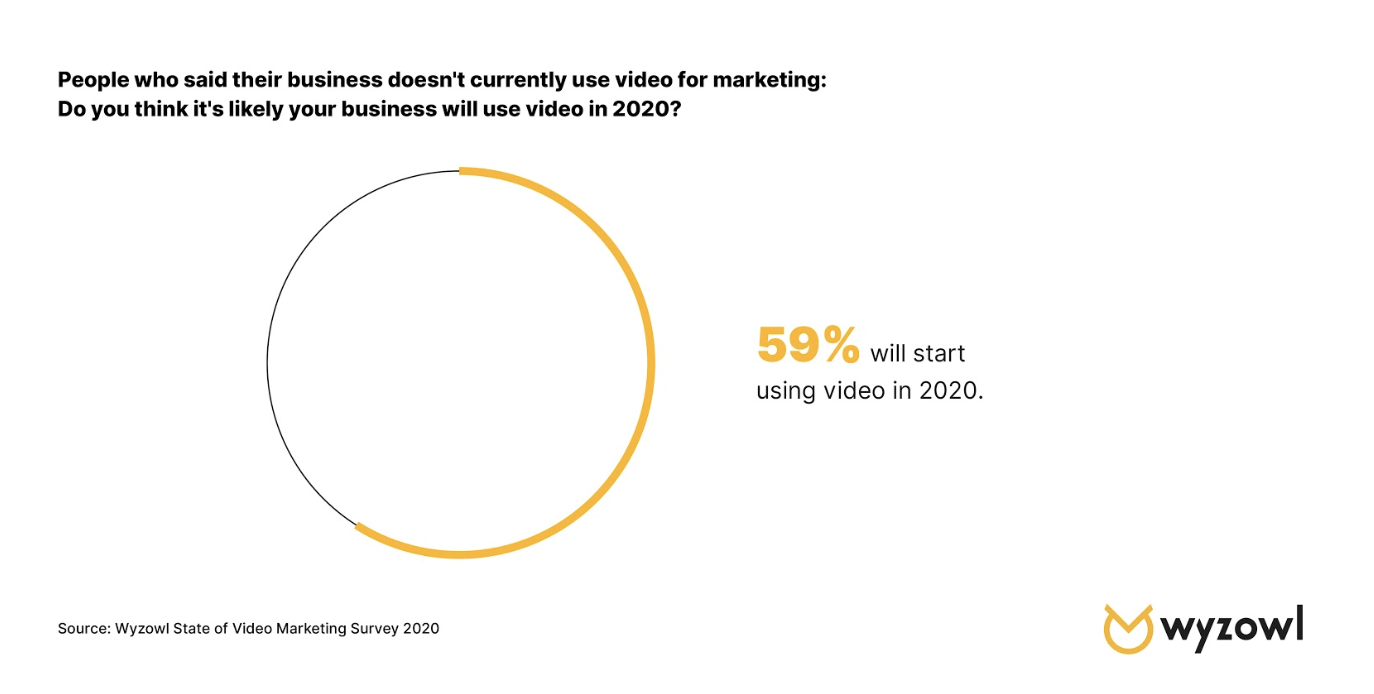
The net result of this is that we can all expect to see more noise and competition for audience attention in the coming 12 months. And, given that 92% of video marketers feel the level of noise and competition increased noticeably in 2019 … that’s a lot of noise!
Of course, while this is a challenge, it isn’t an insurmountable one. It simply raises the bar in terms of content quality. Video needs to be well-planned, and very well-executed.
You’d be forgiven for looking at these numbers and feeling that video might be on the verge of reaching saturation point. Most of the data points around usage, spend and consumer opinion are in the 80s and 90s — where they’ve held, consistently, for a number of years.
But the good news is that there still seems to be underutilized opportunities for marketers to explore around video.
Unsurprisingly, YouTube and Facebook are the most widely used platforms among video marketers — used by 85% and 79%, respectively.
But some of the lesser-used video tactics also seem to be reaping real results for video marketers.
Most notably, for the first time ever, LinkedIn has emerged as the most successful channel for video marketers, with an overwhelming 87% of LinkedIn video marketers describing it as an effective channel.
TikTok — often cited as a video platform with huge potential (and not only by Gary Vee) — remains largely untapped, with only around 1 in 10 video marketers having given it a shot. Out of those who’ve tried it out, though, 66% report having seen success.
There are flops to go with the success stories, too, though. Snapchat continues its poor performance of recent years. Only 11% of video marketers say they’ve used Snapchat as a video channel, and, out of those, less than half report success, making it comfortably the lowest-performing video marketing platform for the third year in a row.
Video looks set to continue its ten-year overnight success story into the coming decade. These stats paint a picture of a media type that’s almost universally popular among both marketers and their audiences, helping achieve a number of incredibly important goals.
You can check out the full report — with plenty more data points — and get a downloadable version by visiting Wyzowls State of Video Marketing 2020 page.
![]()
Bill Slawski of Go Fish Digital shared which patents topped his list this year.
Please visit Search Engine Land for the full article.
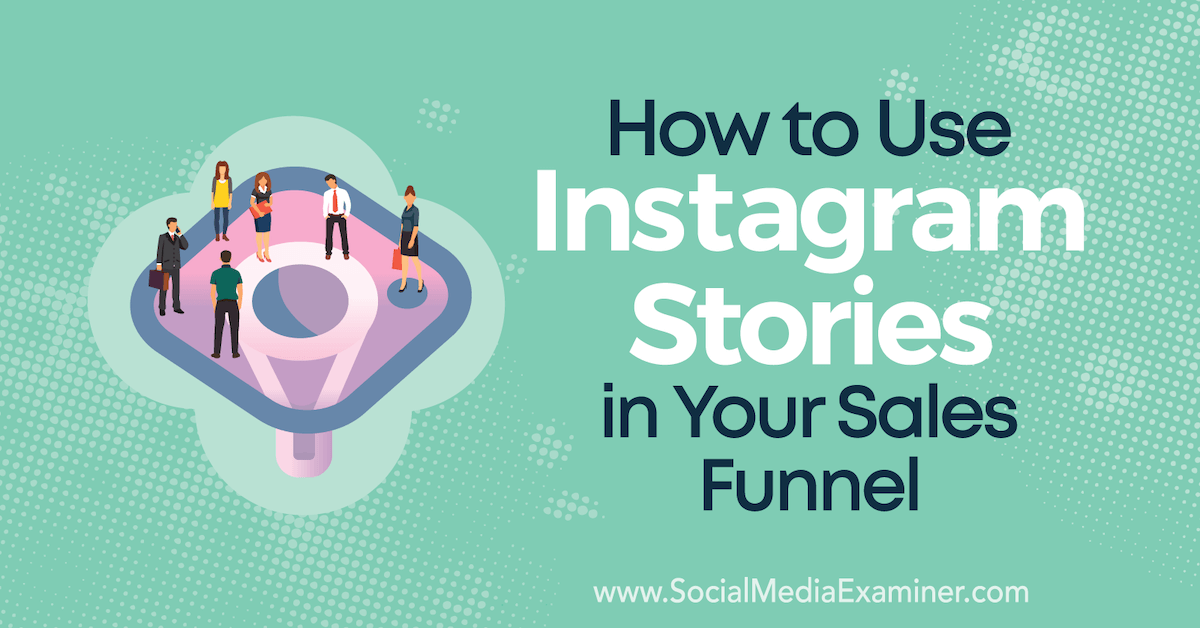
Want to turn Instagram followers into clients? Wondering how to use Instagram stories to nurture warm leads? In this article, you’ll learn how to use Instagram stories to engage and guide people through your sales funnel. #1: Nurture Warm Instagram Leads in the Middle of the Funnel Instagram stories are best used to target followers […]
The post How to Use Instagram Stories in Your Sales Funnel appeared first on Social Media Marketing | Social Media Examiner.
If you’ve had trouble picking a niche, this episode is for you. I spoke with Pamela Slim, business coach and author of the best-seller, Escape from Cubicle Nation and her latest book, Body of Work. We talked about how to develop the language to attract the right people and repel the wrong people to your business. If you like what you hear, write a review, subscribe on Apple Podcasts and, one more thing, be sure to sign up for my Quick Tips from Marketing Mentor.
Did you know:
Pinterest is such a key part of the buying journey for its users that over 90 percent of weekly active Pinners use Pinterest to make purchasing decisions.
Talk about buying power!
Not only are Pinterest users making purchase decisions on the platform, 83 percent say they are making purchases specifically based on the content they’ve seen from brands on Pinterest.
Pinterest is no longer simply a place to save ideas and build dream boards. Instead, Pinterest has turned into the world’s largest visual discovery platform.
And there are a lot of opportunities for brands.
We had a chance to chat with the team over at Pinterest about some of their best practices for brands looking to increase sales. We’re excited to share those lessons with you!
Here’s what we learned…
According to one survey, “47 percent of social media users saw Pinterest as the platform for discovering and shopping for products—more than three times higher than those who cited Facebook or Instagram.”
Seventy-seven percent of weekly Pinners have also discovered a new brand or product on Pinterest, and according to Pinterest, “people actually want to see content from brands while they’re on the platform–78 percent say it’s useful.”
Pinterest might not immediately come to mind as a platform to invest in for many brands, but it should.
Pinterest lives in a unique space on the internet where users are discovering content related to themselves and their aspirations rather than focusing on others, and this has turned it into a powerful platform for users to make purchasing decisions and discover new brands and products.
Clearly, Pinterest is not one to be ignored when it comes to your marketing strategy. Here’s how you can use the platform to drive sales.
There are some really simple ways that you can start leveraging Pinterest to reach new audiences and optimize your pins and profile for sales. Some of these tips might be easy to implement immediately while others might play into later strategies, let’s dive in!
A whopping 97 percent of top searches on Pinterest are unbranded, according to the Pinterest team. For brands, this presents an opportunity to stand out and gain brand recognition through the platform.
Pinterest recommends adding a small logo in one of the four corners of your pin, this can be done really easily in a tool like Canva. You can play around with the design, of course, and add your logo wherever it feels best. In this example from Quip, they went with top centered to fit with the rest of the text on their image.

As with most sites, mobile is extremely important on Pinterest. Eighty-five percent of Pinners are using the mobile app, so it’s important that your content appeals to them while they’re on their phones and appears properly in their feeds. If you’re linking back to your own content, it’s also important that the page that you’re sending users to is mobile friendly as well.
A tip from Pinterest here is to tailor your font size to phone rendering to make sure your fonts are legible on small screens and to design for a vertical aspect ratio. The ideal dimensions are 600 pixels x 900 pixels.

Have you ever clicked on a beautiful image on Pinterest only to be taken to a website that looks nothing like the pin? I have, and it left me really confused.
According to Pinterest, the best practice is to make sure your pins and your website have a similar look and feel, and that doing this pays off. In an analysis from Pinterest, they found that “Pins that went to landing pages with similar imagery had a 13 percent higher online sales lift.”
This example from Ettitude is really great. The pin they are sharing fits seamlessly in a lot of home decor and design tags on Pinterest.

And although their website uses different photos, it still has a similar feel to the pin.

A big element to social media marketing and campaigns is timing. When are people online and when are people talking about the things you want to talk about?
Luckily in the case of Pinterest, they release annual ‘Seasonal Insights,’ which helps take away some of the guesswork. A report that contains more than a dozen specific moments that take place throughout the year.

For example, their 2019 report shared that users start sharing holiday content in June all the way through December and that content related to the Summer starts getting pinned at the beginning of February.
They also have monthly trends reports. Here’s their latest for December 2019 trends on Pinterest, it shares specific trends like the search term ‘peach green tea’ is up 320 percent YoY!
These are great free resources that you can leverage to start timing seasonal campaigns around when people are starting to make specific seasonal purchasing decisions. I would never have thought that people start looking at holiday content in June but that’s super-specific information that can go a long way to help with timely campaigns.
One of the main ways for Pinterest to help generate sales is for the products you are selling to be easily available through Pinterest. Luckily, the platform makes this really easy for brands to set up and feature prominently on their profiles.
Every Business profile on Pinterest has the ability for users to create a “shop” tab.

The shop tab is just what it sounds like, a place where users can go to see all of the products your brand is selling. On the flip side, brands can leverage that tab to share pins that link directly to their sales pages for the specific product.

Pinterest makes this whole process quite easy, they even have a method for importing new products through Pinterest Catalogs. All you have to do is have your data source approved and then as you add new products to your website, they get automagically added to Pinterest as well.
We hope this guide helps you get started with or double down on your efforts with Pinterest. Let us know about your experience with Pinterest in the comments!
If you want even more Pinterest resources, the Pinterest team has created a free Pinterest Academy with tons of lessons in there.
If you’ve had trouble picking a niche, this episode is for you. I spoke with Pamela Slim, business coach and author of the best-seller, Escape from Cubicle Nation and her latest book, Body of Work. We talked about how to develop the language to attract the right people and repel the wrong people to your business. If you like what you hear, write a review, subscribe on Apple Podcasts and, one more thing, be sure to sign up for my Quick Tips from Marketing Mentor.
If you’ve had trouble picking a niche, this episode is for you. I spoke with Pamela Slim, business coach and author of the best-seller, Escape from Cubicle Nation and her latest book, Body of Work. We talked about how to develop the language to attract the right people and repel the wrong people to your business. If you like what you hear, write a review, subscribe on Apple Podcasts and, one more thing, be sure to sign up for my Quick Tips from Marketing Mentor.

Want to turn Instagram followers into clients? Wondering how to use Instagram stories to nurture warm leads? In this article, you’ll learn how to use Instagram stories to engage and guide people through your sales funnel. #1: Nurture Warm Instagram Leads in the Middle of the Funnel Instagram stories are best used to target followers […]
The post How to Use Instagram Stories in Your Sales Funnel appeared first on Social Media Marketing | Social Media Examiner.
If you’ve had trouble picking a niche, this episode is for you. I spoke with Pamela Slim, business coach and author of the best-seller, Escape from Cubicle Nation and her latest book, Body of Work. We talked about how to develop the language to attract the right people and repel the wrong people to your business. If you like what you hear, write a review, subscribe on Apple Podcasts and, one more thing, be sure to sign up for my Quick Tips from Marketing Mentor.